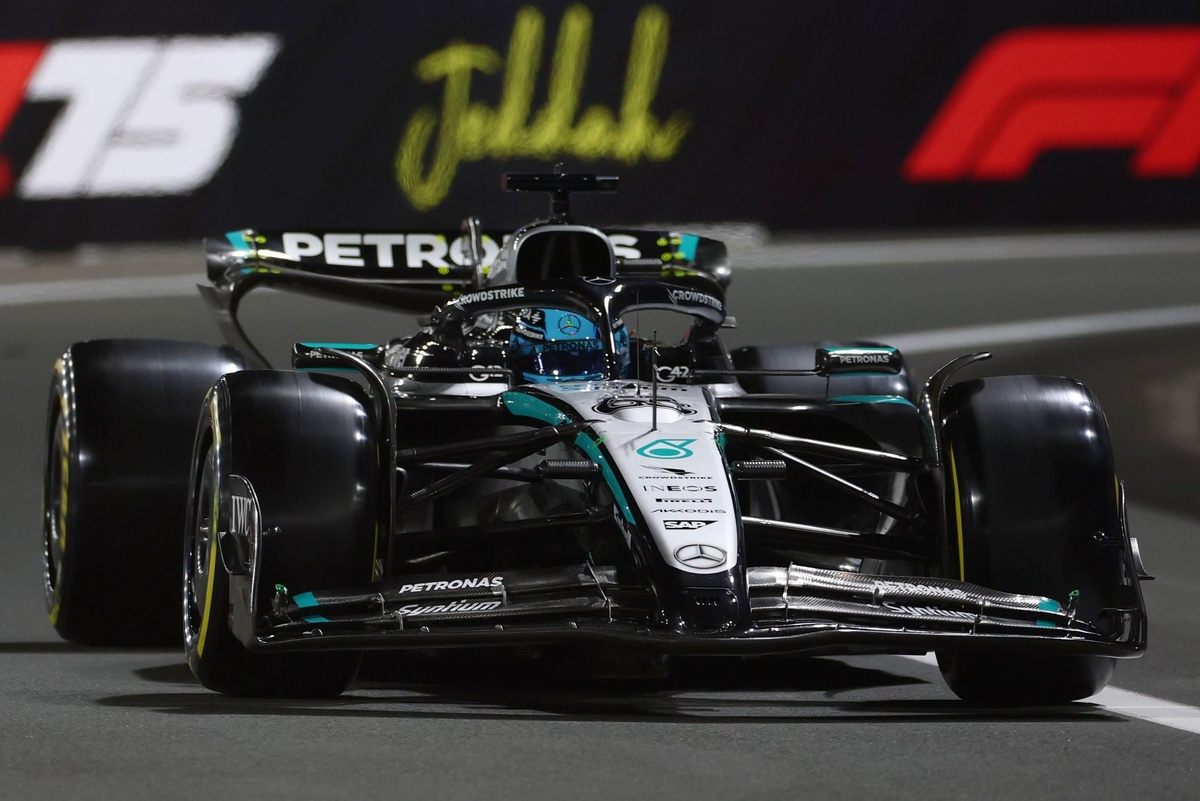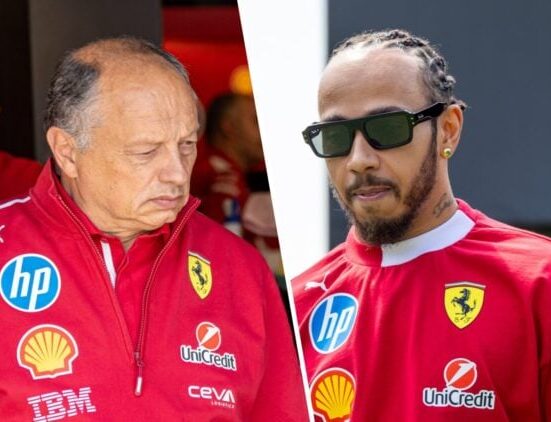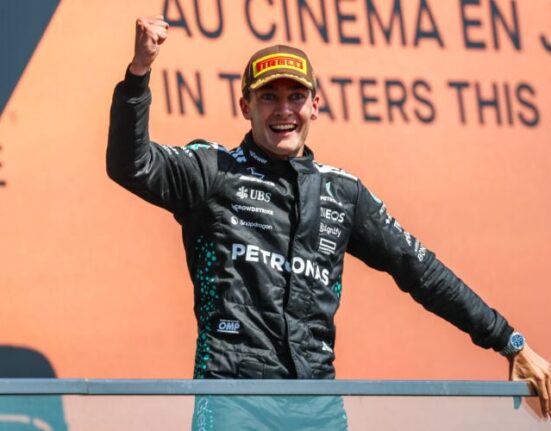Ahead of the Saudi Arabian Grand Prix, one of the recurring themes of the weekend was graining. Graining happens when the tyres are stressed before reaching their optimal operating window, or when ambient temperatures are too low to allow the tyres to work correctly.
Except at Mercedes, the exact opposite was happening: no graining, but rather, blistering. It was an anomaly, rarely discussed since racing started in Saudi Arabia, because the excellent asphalt in Jeddah has always provided a lot of grip, pushing the focus toward the graining issue.
Mercedes was literally “cooking” its tyres while struggling to manage the thermal degradation. It wasn’t just accelerated wear, but rather poor temperature management — the same issue that plagued Max Verstappen during Friday’s long runs.
George Russell, Mercedes
Foto di: Peter Fox – Getty Images
Looking back, during both practice and qualifying, it was noticeable that allowing the tyres to cool helped recover performance — even with the soft tires, where it was possible to attempt two or more laps without a significant drop in tyre performance.
During the race, however, there was no opportunity to slow down and let the tyres breathe, causing the temperature to rise uncontrollably and triggering a chain reaction that reduced grip, increased sliding, and, in turn, further overheated the tires. While Ferrari managed the situation perfectly, even pushing at the end of the first stint and surprising their rivals, Mercedes cooked its tyres.
It made for an unexpected situation, especially considering that in the early season races, the W16 had shown it could manage tyre temperatures well, such as in Bahrain, where the team completed the final stint on soft tyres — a strategy Ferrari even didn’t consider feasible.
George Russell, Mercedes
Foto di: Zak Mauger / Motorsport Images
It’s not a coincidence that Mercedes identified Sakhir as a test track to evaluate if the team had overcome the tyre temperature management issues discovered last year with the W15 on hotter tracks.
And it wasn’t as much of a concern, which is why there was a sense of confidence for the Saudi Arabian race, despite Pirelli deciding to bring softer tyres to increase tyre management and add another variable to the strategy front.
On paper, Jeddah was supposed to be a track well-suited to the characteristics of the W16, which in this early part of the season had shown it could maintain pace in medium-to-high-speed corners but struggled a bit in slower sections. For this reason, Russell’s competitiveness in qualifying wasn’t surprising. And had it not been for the final hairpin, he could have actually claimed pole.
George Russell, Mercedes
Foto di: Lars Baron – Motorsport Images
But from the very first laps, it was clear that Russell was struggling to keep up with the leaders, quickly falling out of Oscar Piastri’s DRS zone, and the dirty air, so it’s unrealistic to say that the issue was the same one that affected Piastri, who had to pit early after stressing his tyres too much trying to stay close to Verstappen.
Race data highlights a vicious circle: the increasing temperatures on Russell’s W16 triggered a noticeable reduction in grip, especially in the medium-to-high-speed corners of the second sector, which had been Mercedes’ strength on Saturday.
“It’s about how fast we’re going through these corners, and for whatever reason, we’ve generated more temperature than our rivals,” Russell said. “Then suddenly you get to a point where the tyres are like a balloon. We had blistering on the front, blistering on the rear, and then suddenly you just have no grip from the tyre at all.”
Comparing telemetries between George Russell and Max Verstappen during the Jeddah Race
Photo by: Gianluca D’Alessandro
In fact, looking at the telemetry data towards the end of the stint, there were almost abysmal differences compared to the race leaders, with speed differences of up to 20 km/h in those sectors where, with fresh tyres in qualifying, the W16 was able to match the pace of the rivals. Even in areas where Mercedes had gained on Saturday, like the long corner at Turn 13 or the quick chicanes at Turns 16/17 or 22/23, the Silver Arrow no longer had that advantage, losing valuable tenths.
“I was pushing hard to stay with Max at the beginning of the second stint,” Russell told Sky Sports F1, “but I knew I wasn’t going to be able to hold on and we fell off that cliff towards the end.
“I was dropping a second a lap in the last 15 laps, but to be fair, we just didn’t have the pace and even if I had managed more, I think I still would have come home in P5.
“We know that it’s a bit of a weakness of our car at the moment. And coming home P5 on a bad day – we’ll take it – but we need to try and improve it quickly.”
What’s interesting is the difference in approach between the two Mercedes drivers, which was almost entirely opposite: while Russell suffered tyre degradation as the stint went on, towards the end, Andrea Kimi Antonelli recorded his best sector times, even getting close to Charles Leclerc’s pace.
Race pace comparison of the Saudi Arabian GP between Kimi Antonelli, George Russell, and Charles Leclerc
Photo by: Gianluca D’Alessandro
The issue was that the Italian had sacrificed the entire first part of the second stint, at times running 7-8 tenths slower than his teammate. Not surprisingly, the gap between Russell and Antonelli significantly reduced only in the final laps, when the Englishman experienced a total collapse, shortening the gap by just a couple of seconds compared to what it had been before the pitstop.
From the early data, Mercedes has yet to find an explanation for the issues seen in the race, but Toto Wolff emphasized that Jeddah represented a setback: “It was clearly our worst performance of the year so far. The pace just dropped away with blistering, overheating tyres and so far we haven’t got an explanation.”










Leave feedback about this